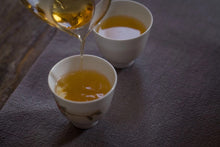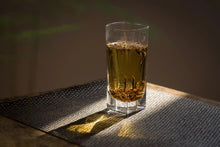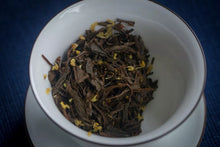
Osmanthus is like sugar sprinkled in the air of Hangzhou City, sweetening people's hearts. Jiuqu Hongmei is the second beauty of Hangzhou. Made in spring and transformed in summer, now it meets osmanthus, elegant and warm. Osmanthus-scented Jiuqu Hongmei, as a characteristic black tea of Hangzhou, whether smelled or sipped, is the unique taste of Hangzhou in this season, mellow, sweet, gentle and warm.
Today, Tongxin She Teahouse recommends "Osmanthus fragrans Jiu Qu Hong Mei".
Jiuqu Hongmei is the only black tea among famous teas in Zhejiang. As one of the "double wonders of the West Lake", it has a reputation no less than that of West Lake Longjing tea. Master Hongyi highly praised it: "Amber color in the white jade cup, plum fragrance at the tip of the red lips and under the tongue."
Two hundred years ago, people who migrated from northern Fujian to southern Zhejiang used the tea tree raw materials for making West Lake Longjing tea and combined with their擅长 black tea-making techniques to give birth to this tea with a long-lasting plum fragrance.
The raw materials of this Jiuqu Hongmei come from the valley slopes above 600 meters above sea level in Qiandao Lake, Hangzhou. The tea trees here are the high-altitude Jukeng species planted during the 1950s and 1960s. Due to the high altitude, long distance, and great difficulty in picking, the tea garden is in a wild state. The relatively primitive natural ecological environment is more conducive to the growth of tea trees and also makes the tea leaves richer in internal substances.
Osmanthus is the city flower of Hangzhou and has even become a major symbol of Hangzhou.
The origin of Hangzhou and osmanthus dates back to Bai Juyi, the old mayor of Hangzhou in the Tang Dynasty. Bai Juyi especially liked osmanthus. In "Recalling Jiangnan", he wrote: "Looking for osmanthus seeds in the mountains and temples under the moon, watching the tide from the county pavilion pillow." In his "Sending a Letter to Master Taoguang", he wrote: "Thinking remotely of where my master walks the path, the heavenly fragrance of osmanthus seeds are falling profusely."
Since the high-altitude Jukeng species is an ancient tea tree species, improper production will produce a bitter taste. Therefore, someone who understands it is needed to make it. So, an experienced master with 30 years of black tea-making experience is invited to personally supervise the production. The currently popular heavy withering and light fermentation process is adopted to maximize the preservation of the original activity of the tea leaves and also leave room for later transformation.
Waiting quietly for a whole summer, osmanthus finally arrives as promised. When Jiuqu Hongmei meets osmanthus, the two blend with each other, with an alluring fragrance and a sweet aftertaste.
The dry tea is jet-black and shiny, with tight and slender strips that are slightly curled. The dried osmanthus is golden and bright, small but radiant. The tea soup is light orange-yellow, bright and transparent, with a slight hint of fine hairs. The tea fragrance in the soup is rich, with floral and fruity scents intertwined, rich in layers, sweet and warm. The tea soup is sweet, soft, and smooth when entering the mouth, fresh, mellow, fine, and moist. As the number of infusions increases, the floral and fruity scents integrated in the soup gradually spread out, implicit and full of tension. The leaf base is tender, with a uniform red color and soft and shiny leaves.
Occasionally, if you want to be lazy, it is also excellent to directly put it into a glass for brewing and drinking, which caters to its personality, not flamboyant but full of connotations.



















